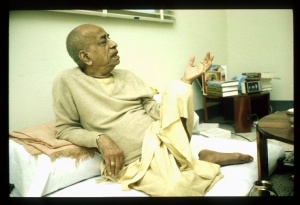CC Antya 1.202 (1975): Difference between revisions
(Vanibot #0027: CCMirror - Mirror CC's 1996 edition to form a basis for 1975) |
(Vanibot #0020: VersionCompareLinker - added a link to the Version Compare feature) |
||
| Line 2: | Line 2: | ||
<div style="float:left">'''[[Sri Caitanya-caritamrta (1975)|Śrī Caitanya-caritāmṛta (1975)]] - [[CC Antya (1975)|Antya-līlā]] - [[CC Antya 1 (1975)|Chapter 1: Śrīla Rūpa Gosvāmī's Second Meeting With the Lord]]'''</div> | <div style="float:left">'''[[Sri Caitanya-caritamrta (1975)|Śrī Caitanya-caritāmṛta (1975)]] - [[CC Antya (1975)|Antya-līlā]] - [[CC Antya 1 (1975)|Chapter 1: Śrīla Rūpa Gosvāmī's Second Meeting With the Lord]]'''</div> | ||
<div style="float:right">[[File:Go-previous.png|link=CC Antya 1.201 (1975)|Antya-līlā 1.201]] '''[[CC Antya 1.201 (1975)|Antya-līlā 1.201]] - [[CC Antya 1.203 (1975)|Antya-līlā 1.203]]''' [[File:Go-next.png|link=CC Antya 1.203 (1975)|Antya-līlā 1.203]]</div> | <div style="float:right">[[File:Go-previous.png|link=CC Antya 1.201 (1975)|Antya-līlā 1.201]] '''[[CC Antya 1.201 (1975)|Antya-līlā 1.201]] - [[CC Antya 1.203 (1975)|Antya-līlā 1.203]]''' [[File:Go-next.png|link=CC Antya 1.203 (1975)|Antya-līlā 1.203]]</div> | ||
{{CompareVersions|CC|Antya 1.202|CC 1975|CC 1996}} | |||
{{RandomImage}} | {{RandomImage}} | ||
==== TEXT 202 ==== | ==== TEXT 202 ==== | ||
| Line 25: | Line 24: | ||
<div class="translation"> | <div class="translation"> | ||
I empowered both of these brothers to go to Vṛndāvana to expand the literature of bhakti." | |||
</div> | </div> | ||
| Line 32: | Line 31: | ||
<div class="purport"> | <div class="purport"> | ||
Śrī Caitanya Mahāprabhu informed Śrīla Rāmānanda Rāya that he and Sanātana Gosvāmī had engaged equally in devotional service after giving up all relationships with material activity. Such renunciation is a symptom of an unalloyed devotee engaged in the service of the Lord with no tinge of material contamination. According to Śrī Caitanya Mahāprabhu, this is the position of tṛṇād api | Śrī Caitanya Mahāprabhu informed Śrīla Rāmānanda Rāya that he and Sanātana Gosvāmī had engaged equally in devotional service after giving up all relationships with material activity. Such renunciation is a symptom of an unalloyed devotee engaged in the service of the Lord with no tinge of material contamination. According to Śrī Caitanya Mahāprabhu, this is the position of tṛṇād api sunīcena taror api sahiṣṇunā. A pure devotee, free from the reactions of the material modes of nature, executes devotional service with tolerance like that of a tree. He also feels humbler than the grass. Such a devotee, who is called niṣkiñcana or free from all material possessions, is always absorbed in emotional love of Godhead. He is reluctant to perform any kind of sense gratification. In other words, such a devotee is free from all material bondage, but he engages in Kṛṣṇa conscious activities. Such expert devotional service is performed without hypocrisy. Humility, renunciation and learned scholarship were combined in Sanātana Gosvāmī, the ideal pure devotee, who was on the same level of understanding as Śrīla Rāmānanda Rāya. Like Rāmānanda Rāya, Sanātana Gosvāmī was a fully cognizant expert in the conclusions of devotional service and was therefore able to describe such transcendental knowledge. | ||
</div> | </div> | ||
Latest revision as of 20:20, 26 January 2020

A.C. Bhaktivedanta Swami Prabhupada
TEXT 202
- ei dui bhāiye āmi pāṭhāiluṅ vṛndāvane
- śakti diyā bhakti-śāstra karite pravartane
SYNONYMS
ei—these; dui—two; bhāiye—brothers; āmi—I; pāṭhāiluṅ—sent; vṛndāvane—to Vṛndāvana; śakti diyā—empowering them; bhakti-śāstra—transcendental literature regarding devotional service; karite—to do; pravartane—establishing.
TRANSLATION
I empowered both of these brothers to go to Vṛndāvana to expand the literature of bhakti."
PURPORT
Śrī Caitanya Mahāprabhu informed Śrīla Rāmānanda Rāya that he and Sanātana Gosvāmī had engaged equally in devotional service after giving up all relationships with material activity. Such renunciation is a symptom of an unalloyed devotee engaged in the service of the Lord with no tinge of material contamination. According to Śrī Caitanya Mahāprabhu, this is the position of tṛṇād api sunīcena taror api sahiṣṇunā. A pure devotee, free from the reactions of the material modes of nature, executes devotional service with tolerance like that of a tree. He also feels humbler than the grass. Such a devotee, who is called niṣkiñcana or free from all material possessions, is always absorbed in emotional love of Godhead. He is reluctant to perform any kind of sense gratification. In other words, such a devotee is free from all material bondage, but he engages in Kṛṣṇa conscious activities. Such expert devotional service is performed without hypocrisy. Humility, renunciation and learned scholarship were combined in Sanātana Gosvāmī, the ideal pure devotee, who was on the same level of understanding as Śrīla Rāmānanda Rāya. Like Rāmānanda Rāya, Sanātana Gosvāmī was a fully cognizant expert in the conclusions of devotional service and was therefore able to describe such transcendental knowledge.